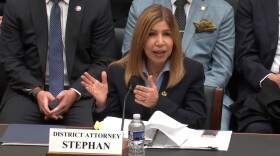The California Department of Food and Agriculture Thursday declared a new citrus quarantine in Valley Center after detecting the citrus tree disease known as Huanglongbing — or citrus greening — in five orange trees on a residential property.
The state detected the tree-killing bacterial disease during routine inspections. It is a major threat to San Diego County's $138 million annual citrus crop and can impact residential citrus tree owners, a statement from the county read.
HLB causes misshapen, bitter fruit and eventually kills infected trees. There are more than 120 growers with approximately 1,100 acres of commercial citrus and 120 nurseries that may have citrus trees within the Valley Center quarantine. The commodities on these Valley Center properties are valued at $19.4 million.
"Unfortunately, Huanglongbing is fatal to citrus," San Diego Agricultural Commissioner Ha Dang said, "so our goal is to prevent this disease from spreading any farther.
"By working together, we can all protect our food supply, local agriculture and environment from this devastating disease," she said. "Partnering with state and federal regulatory partners, we are working closely with residents and agricultural operators and ask for everyone's cooperation with the ongoing regulatory activities."
Enrico Ferro is the county’s citrus pest control district manager. He said the disease can impact both commercial and residential citrus tree owners.
“Somewhere in the range of 60% of homes in Southern California have citrus trees, so it's always a concern because, once the tree is infected, it will die within three to five years most likely,” Ferro said.
Citrus greening disease devastated the Florida citrus industry over the past two decades.
HLB quarantines already exist in the city of Oceanside and neighborhood of Rancho Bernardo. The new area covers the area bordered on the north by the intersection of I-76 and Pala Road; to the south by I-15 and Deer Springs Road; to the west by Camino del Rey; and to the east by Valley Center.
“They pose a real threat to other citrus areas. Especially Pauma Valley, which is right next door, that has a lot of commercial citrus,” Ferro said.
The only exception to the quarantine is for agricultural businesses that must adhere to specific requirements for treatment, cleaning and packing commercial fruit prior to movement.
The disease is not harmful to people or animals. HLB is spread by tiny insects, the Asian citrus psyllid, if they are carrying the bacterium when they feed on citrus trees.
“The insect has an orange color to it, and, when they start to feed, they produce kind of a white ribbon that has plant sugars in it,” Ferro said.
The CDFA and County Department of Agriculture, Weights and Measures will work with residents in the immediate area to arrange for treatment of citrus trees as a protective measure against the disease. County officials are also proactively notifying local citrus growers, plant nurseries and other related businesses.
According to the county, if the disease is detected in additional citrus trees in the quarantine area, CDFA officials will contact properties regarding treatment and removal of the infected trees. Nearby trees will be treated and regulatory survey efforts will be increased to prevent the spread of the disease in the area.
"Infected trees may have areas with mottled yellow leaves, generally seen in asymmetrical patterns and bear small, asymmetrical fruit which are partially green, bitter, and not fit for sale or eating," the county statement reads. "The disease destroys the appearance and economic value of the trees and eventually causes their death, typically within a few years."
Inside the quarantine area, residents are urged to take the following steps:
- Do not move citrus plants, leaves, or foliage into or out of the quarantine area.
- Cooperate with agricultural officials who are inspecting trees, taking samples and treating for the pest.
- If residents no longer wish to care for a citrus tree, consider contacting a tree removal service to discuss options to help ensure that trees do not continue to be a host to the pest and disease.
- Only buy citrus trees from reputable local nurseries.
- Report citrus trees that seem to be sick or dying even though they also appear to be well-watered and well-maintained by contacting CDFA's toll free Pest Hotline at 800-491-1899 or visit cdfa.ca.gov/plant/acp.
For questions regarding moving commercial citrus and HLB quarantine regulations, contact the San Diego Department of Agriculture, Weights, and Measures at 760-752-4700 or visit sdcawm.org.






